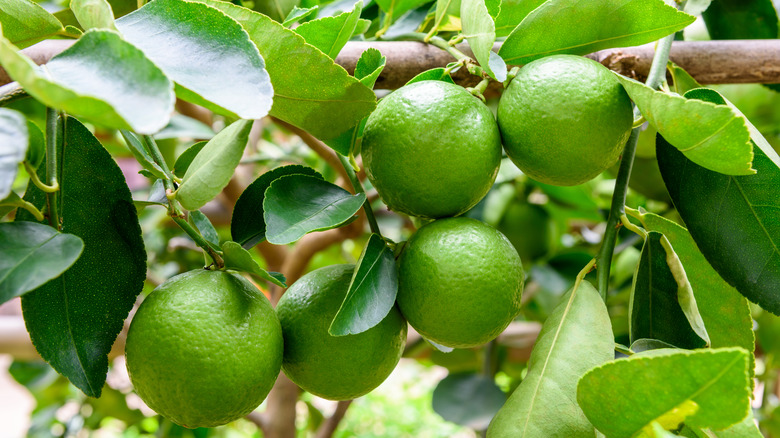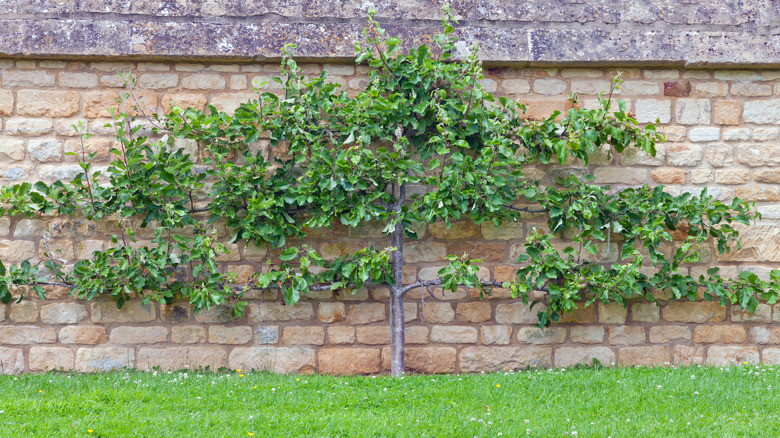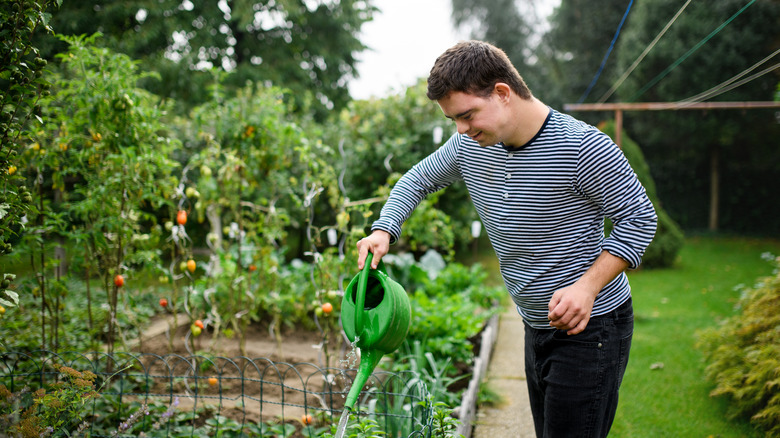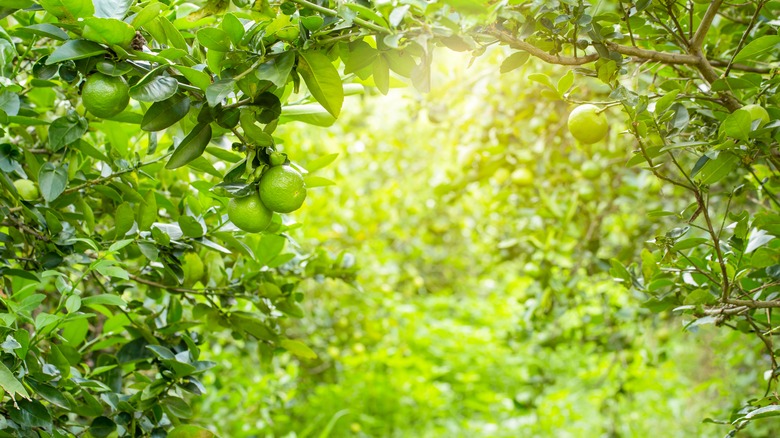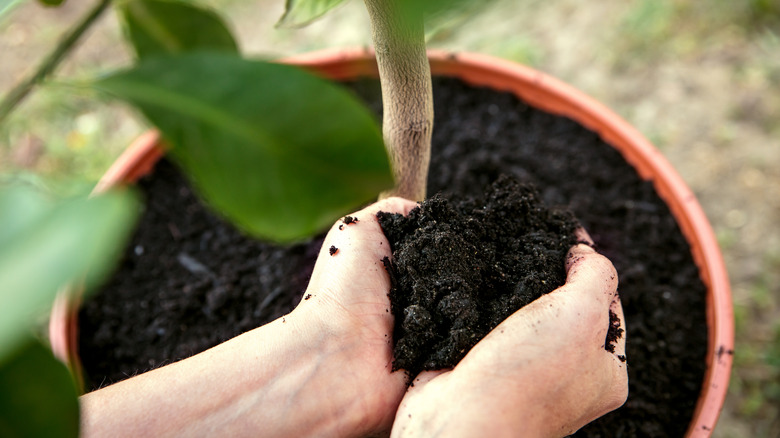How To Grow And Care For Your Lime Tree
Lime trees are part of the genus citrus, which hosts the Rutaceae family, and are important products for commercial and personal use, according to Britannica. Some pickles and chutneys rely on lime as a crucial ingredient, but the fruit is also used to add a touch of flavor to certain drinks and food. The great thing about limes is that they can be used in different ways, such as dried, frozen, or canned. If you're someone who loves adding this citrus to everything, a lime tree plant may be a fun way to harvest that ingredient. However, Gardening Channel does say it does take three to four years for your tree to produce fruit.
Limes are expected to have come from Indonesia or close to mainland Asia. Still, they didn't make it over to the western Mediterranean countries until the 12th and 13th centuries, Britannica says. It's said that Christopher Columbus took a few citrus seeds, possibly lime seeds as well, to the West Indies in 1493. These seeds were then planted in areas such as Mexico and Florida. Lime seeds have also gone through a long voyage at sea and were used by the British Navy to resist the effects of scurvy, giving it the nickname limey.
How to use a lime tree in the garden
Luckily, there are multiple ways to use a lime tree in your garden, according to Houzz. You can train it to either be a tree or a shrub, which is done by pruning the plant to rid it of frail or dead branches. Once you've created the shape you like, you can then place it in a small orchard, a large pot, or plant it as an anchor in a garden bed. If placed somewhere nearby, you'll be able to enjoy its lovely aroma.
For those who want quick and easy access to their lime tree for food preparations, you can also grow it by your patio, deck, or outdoor eating area so you'll be able to quickly pluck the limes you'll need. If you use an espalier lime tree, it can be enjoyed right beside a wall, fence, or even on top of an arbor or pergola to create a beautiful and fresh appearance.
How to grow a lime tree
Gardening Channel believes it's best to start the growing process of a lime tree indoors before eventually placing it outside during the summer. They advise purchasing a tree that is considered to be a part of the dwarf variety, so it can stay under 8 or 10 feet tall. To ensure your plant is healthy, make sure to wash it to prevent any root disease it may be prone to.
The lime tree then should be placed in a plastic, ceramic, or clay pot. The pot should be a little bigger than the rootball of the tree and should have plenty of drainage holes. In order to easily move the tree outside, a pot with coasters will be the best option for you. If possible, it's also best to purchase soil that is specifically used for citrus fruits. If you cannot obtain that, you can use light and loamy potting soil instead.
How to care for a lime tree
According to Gardening Channel, lime shrubs are plants that really enjoy their sunlight. This fruit tree typically needs about six to eight hours of sunlight every day, which is best received on a clear day. If your lime tree currently grows inside the house, ensure that it's sitting by a sunny window. In the winter, when there is no sun, it's advised to use a grow light as the sunlight is scarce but the cultivar really needs it to thrive. Lime trees also require a space that keeps them between 55°F and 85°F, but 65°F is the golden number.
The soil a lime tree is planted in must be watered enough to ensure it is slightly moist. However, if the soil gets too soggy, it can lead to fungus growth, or your tree can suffer from root rot. To prevent this, you must occasionally dry out the soil a bit. This practice should be part of your watering schedule. If inside, keep the plant moist by placing it near a humidifier or softly spraying it.
Lime tree varieties
One of the healthiest citrus plants (and part of the Rutaceae family), there are plenty of lime tree types to choose from, Britannica says; there are more than 2,000 varieties of citrus shrubs and trees available. Most trees also grow flowers that are not only beautiful but produce a pleasant fragrance as well. The great majority, though, are crucial food crops used in recipes and are gorgeous enough to elevate your yard's appearance. Here are a few of the available citrus varieties, courtesy of the University of California Riverside.
- Bergamot orange (Citrus aurantium) has a floral scent used in perfumes and flavoring. It's also a great plant to attract bees, butterflies, and hummingbirds.
- Citron (Citrus medica) is a fruit used in Jewish religious rites, David Publishing notes, and its peel is thick enough to create a candy that is sold in certain regions. It is also capable of growing 11 feet.
- Grapefruit (Citrus paradisi) is an edible fruit that is also called pomelo. It's possible it originated in Barbados and became a favorite in the West Indies.
- Arancino lemon (Citrus limon) produces a juice people use to make pastries and desserts. This fruit was welcomed by Spain and North America somewhere between 1,000 and 1,200 CE.
- Tangerine (Citrus reticulata) possibly originated from Southeast Asia, Libertyprim' says, and was eventually introduced to the westward trade. This fruit is similar to oranges but is smaller and is a species of the mandarin orange family.
Is the lime tree toxic?
Lime trees are typically safe for humans but can be toxic to dogs when consumed in large amounts, according to Wag! This type of poisoning in dogs happens because of the psoralen compounds and the essential oils of limonene and linalool present in the fruit. If you are worried your dog may be experiencing poisoning after eating too much citrus, there are certain symptoms to look out for, including cold limbs, collapse, diarrhea, rash, and tremors.
However, the antioxidants present in limes have been noted to reduce inflammation and possibly prevent chronic illness in humans. The high levels of vitamin C can also be useful in protecting you from infection while also speeding up the ability for you to heal your body. For those who suffer from kidney stones, you can use limes to prevent them from forming. Those low in vitamin A, calcium, and iron would also benefit from including limes in their diet. Although limes have plenty of health benefits, too much of anything is not a good idea. If you eat too many limes, it can damage your teeth because of their acidity, Mouth Healthy notes.
How to repot a lime tree
According to Potted Citrus Trees, it's time to repot your lime tree when its roots begin to poke out of the drain holes. Lime trees should be repotted every two years until the age of seven and should happen right before spring, especially if you want to avoid nutrition deficiencies. The pot in which you need to plant your citrus varies by the tree's age; two to three years old trees should get a 5-gallon container, four to five years old trees need a 10-gallon pot, and six to seven years old lime trees should be planted in a 15- or 20-gallon pot.
The soil needed to repot lime trees should have drainage capabilities and provide plenty amounts of nitrogen. To ensure ample drainage, the dirt should also contain sand and perlite. In the repotting process, ensure there is no root rot. If there's none, center your plant in a larger pot and softly compact the soil you're using. Once repotted, water the lime tree with plenty of water. This will signal the plant that it has been moved into a new pot.
